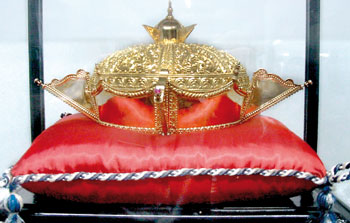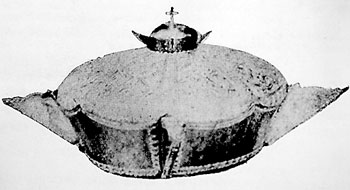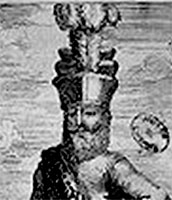Fifty years ago, in the morning of September 19, 1961, the assistant curator of the Kandy museum opened the doors and to his amazement found the crown of King Rajasinghe II missing from its usual display. He also noticed an opening in the wooden ceiling of the centre gallery of the museum and that the door of the glass show case had been forced open. The police visited the scene of the crime but no information was forthcoming on any potential suspects. The daring deed, it seemed, had been carried out leaving no trail.
One of the museum watchmen admitted to the police that he had heard the barking of stray dogs from the direction that was later determined as the entry and exit point of the burglars that night. However, the watcher did not check the area. With the search unsuccessful, the matter was handed over to the Criminal Investigation Department (CID) and Inspector Rodney Kithulegoda was assigned the investigation.
The legend of King Rajasinghe II
and his crown
Rajasinghe II (c 1612-1687) was another of Sri Lanka’s warrior kings along with his namesake, the first Rajasinghe. There is a strong legend surrounding the crown and its long time abode in the Devale (shrine) at Dodamwela - a typical Kandyan hamlet that remains enchanting to date. On the way to battle, the royal palanquin collapsed, when one of the supporting staves snapped for no apparent reason.
On investigating, the king was informed by his men that the deity presiding in the shrine was very powerful.
Impressed, the king then vowed that if he succeeded in defeating the Portuguese invader, he would present his crown along with swords from the battle to the shrine. He emerged victorious in the famed battle of Gannoruwa in 1638, on the outskirts of Kandy, routing the occupying forces of General Diego De Melo. Upon securing his victory the triumphant monarch vested the crown as fulfillment of the vow to the deity in the Dodamwela shrine. It remained there until it was transferred to the Kandy museum in the 20th century.
Initial breakthrough
On October 7, 1961, the CID in Colombo received a significant lead that well amounted to a stroke of luck. A CID officer had received some startling information about an ex-convict in Kelaniya, L.E. Perera, who appeared to have a large amount of jewellery and that Perera had hosted a fellow ex-convict named Kirthipala. No sooner this information was received, the Perera residence in Kelaniya was placed under police surveillance and other police stations were alerted to watch for the two suspects in this crime.
 |
| The original crown as depicted in Paul E. Pieris's book "The Portuguese Era" Vol II (below) and (above) the replica at Kandy museum. |
 |
On October 8, information was relayed to the CID that Kirthipala had been apprehended by the Galle police along with L.E. Perera. Not wishing to waste any more time the police moved in on the Perera residence with a search warrant. CID officers searched the house and found a suitcase containing 41 red precious stones wrapped in a piece of cloth, two fragments of gold coloured metal with a floral design on it and a pair of pliers alongside the items.
The curator of the Kandy museum was contacted and after inspecting the fragments, he felt certain they were parts of the crown. With that the CID decided to bring Kirthipala and L.E. Perera from Galle to Colombo for interrogation. Predictably, Kirthipala and Perera started by denying any involvement and Perera subsequently recanted, following it with full disclosure. With that the plot began to unravel piece by piece.
Perera disclosed that in September that year, shortly before the break-in at the museum, Kirthipala had called on him in Kelaniya. Both were former convicts and the pair had decided to visit Kandy. On September 11, 1961 they toured the town and later they walked along the scenic lake bund. Then they decided, fatefully, to visit the Kandy museum where they saw among the other exhibits, mounted in a glass case, the historic crown of King Rajasinghe II.
On the following day, September 12, 1961, the two had left Kandy for Kelaniya by bus but Kirthipala had got down on the way at Kegalle saying he wanted to visit one John whose home in reality turned out to be one of his hideouts. The CID traced John to his village near Kegalle and John corroborated Kirthipala’s arrival at his home. He then provided an account of the events since Kirthipala’s arrival.
On September 18, Kirthipala had first consulted a fortune teller pretending it was for a court case. He was foretold of great success. Kirthipala and John had both then left the village for Kandy.
That evening in Kandy they met with another acquaintance of Kirthipala’s, one Hendrick (known also as Thegis), who was accompanied by a youngster named Farook. Hendrick and Kirthipala had gone on their own leaving John and Farook at the bus shelter for Colombo bound buses by the town’s clock tower.
The CID reviewed their records and found out Hendrick was an ex-convict living in Matale. They also found out that he visited the Ankumbura sub post office to collect an allowance. The CID team waited in ambush in order to apprehend him. After a couple of false starts, Hendrick was sighted and taken for further questioning. With that the events of the night of September 18, 1961 began to unfold.
Events of September 18
Hendrick had gone on September 18, 1961 to Kandy town to while away the day and was walking on the lake bund when he encountered Kirthipala, whom he knew from jail and John. Kirthipala had enquired about places to burgle.
He had then mentioned that he had scouted the area around the Kandy museum about thrice now.
At nightfall, leaving John and Farook at the bus shelter, Kirthipala took Hendrick and wound his way to the back of the museum via the adjoining quarters of the Assistant Curator and vaulted over a wire fence into the museum compound.
They then inched their way until they were outside the wall of the museum toilet structure which abutted the main museum building. Kirthipala had asked Hendrick to crouch by the wall. Kirthipala then stood on his shoulders and hoisted himself onto the flat concrete roof of the toilet building.
Hendrick had lingered a few more minutes and then left making his way into Kandy town. As he never retracted his initial denial, Kirthipala’s own thoughts and actions once inside the museum will never be fully known.
 |
| King Rajasinghe II |
That he let himself in from the roof was clear, once atop the concrete roof of the toilets. He had dislodged the outermost Calicut tiles of the main museum building’s roof. From there he had crawled on to the ceiling and made his way to a point from which he could cut an opening with his knife and then agilely lowered himself into the main gallery of the museum. One can only guess at Kirthipala’s feelings when he saw there in the semi darkness of the main gallery, well within his reach now, faintly glistening in the glass casing – the crown of King Rajasinghe II.
John recalled that around 2.30 a.m. a visibly excited Kirthipala had arrived at the bus shelter carrying a paper bag. Kirthipala’s hair was dishevelled and his shirt was noticeably wet. He had not met Hendrick on his way though. Kirthipala took John aside and mentioned that he had with him the crown from the museum, wrapped in newspaper and placed in a paper bag. He had carried out the entire heist unopposed except for some stray dogs barking at the museum.
The two then boarded the next (hourly) bus for Colombo but got off at Mawanella, and stopped at a tea boutique. There they had parted ways; Kirthipala went to Colombo and John back to his village not far from there.
Back to Kelaniya
On the morning of September 19, 1961, the day following the burglary, Kirthipala turned up at the door of L.E. Perera in Kelaniya bearing the paper bag. L.E. Perera let him in and took a quick glance at the contents of the bag, where he recognised immediately the crown of King Rajasinghe II.
Kirthipala asked Perera to get the bag weighed at a nearby shop and discovered it weighed 15 ½ ozs. The shopkeeper was curious as to its contents and Perera had defensively said it was his wife’s jewellery.
This suspicious encounter led the shopkeeper to subsequently inform the police.
Afterward, when the rest of the Perera household was usually asleep around 9 p.m. Kirthipala and L.E. Perera removed and placed the crown of King Rajasinghe II – intact for the last time in its centuries of existence – on a mat.
Then, in an act of utter vandalism, they shredded the crown with a large scissor into as many as 300 pieces of a square inch each and replaced them in the same brown paper bag. A pair of pliers was also used to prise out the precious stones, mainly red ones that were crafted into the floral motif on the crown and then these were wrapped in a small piece of cloth lest they tumble out. The pair then turned in for the night, their deeds amounting to nothing short of an inestimable loss of a centuries-old national treasure.
Around 9.30 a.m. the following day, Kirthipala left for Colombo taking the bag containing pieces of the crown. There he had given the bag to one Somay and asked him to sell the contents. He then returned to Kelaniya and requested Perera to go later and fetch Somay.
When he was about to leave, Hendrick who had read in the local newspaper of the theft of the crown appeared at his door for his share of the proceeds of the burglary.
Meanwhile, Somay had visited a jeweller in the Pettah who had directed him to another jeweller who had offered him the royal sum Rs. 2,010 for the gold pieces. When Perera returned with Somay, the latter had handed over the money to Kirthipala who in turn rewarded the group of ex -convicts and then made merry with a bottle of Arrack.
The trail ends
When Somay later confessed this to the CID, the police hastened to the jeweller’s store but alas, despite their best efforts, they were days too late. The second jeweller had wanted the pieces smelted to ensure, of all things, that the gold was genuine - totally unaware that the fragments came from the royal crown and could not have been crafted of anything less. The gold pieces, more than three hundred in all, had been emptied into a receptacle that was placed in the furnace to melt. As the precious metal liquefied in the crucible, the truly last hope of ever reconstructing the invaluable crown was gone.
Once melted, the gold was determined sufficient to mould thirty six coins most fittingly called sovereigns. A further twelve smaller coins were made as well. These were then given to a goldsmith around the 10th of October 1961 who fashioned out twenty five gold rings with them and, with a final touch of irony, inscribed the word ‘Sri’ on them. Some rings had been sold already with no record of the buyers, making the loss irredeemable.
Fifty years have now passed since the theft of this national treasure. The main two culprits for this dastardly deed died in prison while serving their sentence. The CID team that cracked the case led by Rodney Kithulegoda have since retired from service. A copy of the crown was crafted in the 1970s and is now displayed in the Kandy museum. Yet, it barely compensates for the loss of the original crown and all its historical glory.
The nation, for all its centuries of history, was now left in possession of only one crown for posterity - that of its last king. The crown of King Rajasinghe II was gone forever.
(The writer who has had an abiding interest in Kandyan history from his schooldays at Trinity College, lives in Canada. Now working for the Federal Government in the Canada Revenue Agency (Tax Dept), he was formerly a Staff Officer in the Central Bank of Sri Lanka) |




